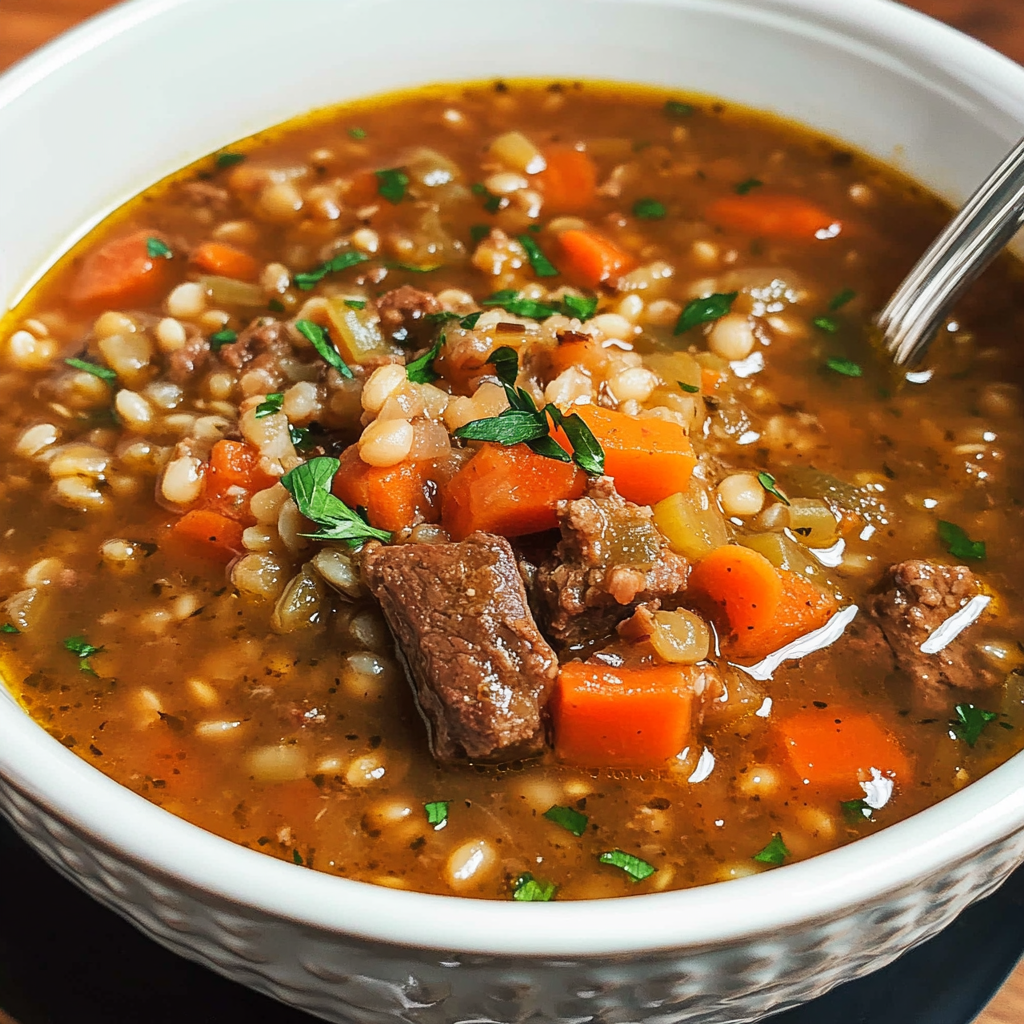Introduction to Vegetable Beef Barley Soup
Vegetable Beef Barley Soup stands as a testament to comfort food at its finest. This hearty soup combines tender chunks of beef, nutritious barley, and a variety of vegetables, all simmered together to create a rich and satisfying meal. It’s a dish that not only warms the body but also comforts the soul.
Historical Background and Popularity
Vegetable Beef Barley Soup has a rich history that traces back to rustic kitchens where simplicity and nourishment were key. Originating as a peasant dish, it has stood the test of time, evolving into a beloved classic in many cultures. The soup’s versatility in accommodating various local ingredients contributed to its widespread popularity. It’s a dish that has crossed borders and been adapted in countless ways, reflecting the culinary traditions and preferences of different regions.
- Beef: The foundation of the soup. For the best results, understanding different cuts of beef is crucial. Beef Cuts Guide offers an in-depth look into selecting the right beef for your soup.
- Barley: A nutritious grain, barley adds texture and richness. It’s a source of dietary fiber and essential nutrients.
- Vegetables: They bring color, flavor, and additional nutritional benefits to the soup.
Ingredients and Nutritional Value for Vegetable Beef Barley Soup
Key Ingredients Overview
At the heart of Vegetable Beef Barley Soup are three essential components: beef, barley, and a variety of vegetables. Each ingredient contributes significantly to the soup’s flavor and nutritional profile.
- Beef: This is the star of the soup, providing a rich source of protein and depth of flavor. Tender cuts like chuck roast or stew meat work best, as they become exceptionally tender and flavorful when simmered.
- Barley: A wholesome grain, barley adds a unique texture and nuttiness to the soup. It’s not just a filler; barley is rich in fiber and essential nutrients, contributing to the soup’s heartiness and health benefits.Learn more about its nutritional benefits at the Whole Grains Council.
- Vegetables: Commonly used vegetables include carrots, celery, and onions, which form the aromatic base of the soup. They infuse it with essential vitamins and minerals, while other seasonal vegetables can be added for variety and additional nutrition.
Nutritional Analysis
Vegetable Beef Barley Soup is a nutritional powerhouse, offering a balanced blend of proteins, carbohydrates, fibers, vitamins, and minerals. The beef in the soup provides high-quality protein essential for muscle repair and growth, making it an excellent choice for a post-workout meal or for those seeking to increase their protein intake. Barley, a key ingredient, is a whole grain rich in dietary fiber, which aids in digestion and promotes a feeling of fullness, contributing to weight management.
- Health Benefits: This soup is a powerhouse of nutrients. It’s rich in protein, fiber, and essential vitamins, making it an ideal meal for health-conscious individuals.
Cooking Techniques about Vegetable Beef Barley Soup
Variations and Serving Suggestions
Variations of the Recipe
Vegetable Beef Barley Soup is a versatile dish that welcomes creativity. For a vegetarian twist, replace beef with hearty mushrooms or beans, which add a similar richness and texture. Experiment with different vegetables like sweet potatoes, parsnips, or kale for a seasonal touch. To spice things up, add a dash of paprika or cayenne pepper. For those preferring a lighter version, chicken or turkey can substitute for beef. Barley can also be replaced with other grains like quinoa or brown rice, offering a different texture and nutritional profile. Each variation not only alters the flavor profile but also caters to different dietary preferences and needs.
Serving Suggestions
Serve this comforting soup with a side of crusty bread, perfect for dipping and soaking up the flavorful broth. A fresh green salad with a light vinaigrette complements the heartiness of the soup, adding a crisp, refreshing element to the meal. For a more filling option, pair it with a grilled cheese sandwich, combining the warmth of the soup with the gooey, melted cheese. Garnishing the soup with a sprinkle of fresh herbs or a dollop of sour cream before serving adds an extra layer of flavor and makes for an appealing presentation.

Storage and Reheating
Best Practices for Storing
To store Vegetable Beef Barley Soup, first allow it to cool to room temperature. Avoid leaving it out for more than two hours to prevent bacterial growth. Transfer the soup into airtight containers, which helps preserve its freshness and prevents absorbing other flavors from the fridge. If you plan to keep the soup for more than a couple of days, consider freezing it. The soup freezes well and can last for up to three months in the freezer. Remember to leave some space at the top of the containers as the soup will expand when frozen.
Tips for Reheating Without Losing Flavor
When reheating Vegetable Beef Barley Soup, do so gently over medium heat on the stove. Stirring occasionally helps distribute heat evenly and prevents the bottom from burning. If the soup has thickened in the fridge, add a bit of water or stock to reach the desired consistency. For microwave reheating, cover the soup with a microwave-safe lid or plastic wrap, leaving a small vent for steam to escape. Heat in short intervals, stirring in between, to ensure even warming. Avoid overheating as it can diminish the soup’s flavor and texture.
FAQs about Vegetable Beef Barley Soup
Can this soup be made in a slow cooker?
Absolutely! Vegetable Beef Barley Soup adapts well to slow cooking, which enhances the flavors and tenderizes the beef beautifully. Start by browning the beef and sautéing the onions and garlic in a skillet before transferring them to the slow cooker. Add the rest of the ingredients, except for the barley, and cook on low for 6-8 hours or on high for 3-4 hours. Add the barley during the last hour of cooking to prevent it from becoming too mushy.
How can I make this soup gluten-free?
To make Vegetable Beef Barley Soup gluten-free, replace barley with a gluten-free grain like quinoa or brown rice. Ensure that the beef broth and any other added ingredients like Worcestershire sauce are certified gluten-free. Always check labels when purchasing ingredients to avoid hidden gluten sources.
What are some tips for making this soup more flavorful?
To enhance the flavor of the soup, consider the following tips:
- Use homemade beef stock or a high-quality store-bought version for a richer taste.
- Roast the vegetables before adding them to the soup to deepen their flavors.
- Incorporate fresh herbs like thyme and rosemary for a fresh, aromatic touch.
- Brown the beef well before adding it to the soup, as this adds a depth of flavor from the caramelization.
- Don’t rush the cooking process; a slow simmer allows the flavors to meld together beautifully.
Can this soup be frozen for later use?
Yes, Vegetable Beef Barley Soup freezes exceptionally well. Cool the soup completely and store it in freezer-safe containers or bags. It can be kept in the freezer for up to 3 months. When ready to eat, thaw it in the refrigerator overnight and reheat gently on the stove or in the microwave, adding a little extra broth if needed to adjust the consistency.
Conclusion of Vegetable Beef Barley Soup
In essence, Vegetable Beef Barley Soup is more than just a hearty beef soup; it’s a culinary embrace, rich in nutritious barley and healthy vegetable mix. This homemade soup, a staple of winter comfort food, offers a slow-cooked flavor that is both satisfying and nourishing. As a family dinner idea, it’s a perfect example of cozy meal excellence, blending savory broth, tender meat, and wholesome ingredients. Whether you’re seeking a low-fat recipe or a dish rich in dietary fiber, this soup stands out as a versatile, delicious, and healthy family meal option.




